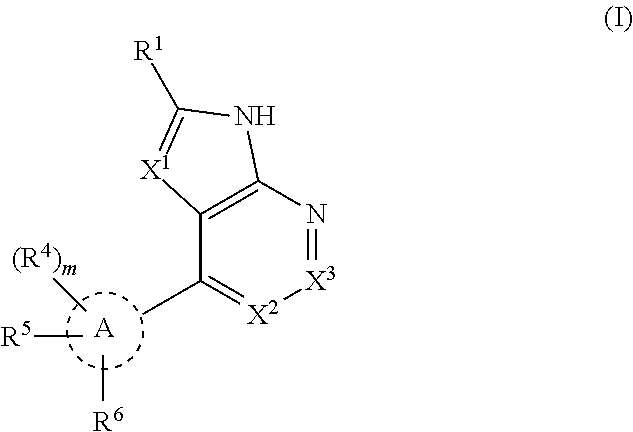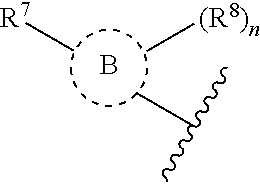Tank-binding kinase inhibitor compounds
a kinase inhibitor and kinase technology, applied in the field of kinase inhibitor compounds, can solve problems such as their decreased viability
- Summary
- Abstract
- Description
- Claims
- Application Information
AI Technical Summary
Benefits of technology
Problems solved by technology
Method used
Image
Examples
example 1
Preparation of 5-(2-(3,4-dimethoxyphenyl)-1H-pyrrolo[2,3-b]pyridin-4-yl)-2-((tetrahydro-2H-pyran-4-yl)oxy)benzonitrile
[0302]
[0303]Step 1: A sealed tube containing a suspension of 5-(2-iodo-1-(phenylsulfonyl) 1H-pyrrolo[2,3-b]pyridin-4-yl)-2-((tetrahydro-2H-pyran-4-yl)oxy)benzonitrile (100 mg, 0.171 mmol) and Pd(PPh3)4 (9 mg, 0.008 mmol) in a degassed mixture of dioxane / H2O (1.5 mL, 4 / 1), was preheated at 85° C. for 5 min. Next, K2CO3(59 mg, 0.427 mmol) and 2-(3,4-dimethoxyphenyl)-4,4,5,5-tetramethyl-1,3,2-dioxaborolane (68 mg, 0.257 mmol), were added to the mixture and the reaction was additionally heated at 100° C. in the sealed tube for 15 hrs. Afterwards, the crude material was allowed to reach room temperature. It was diluted with EtOAc and filtered through a short pad of Celite, washing the solids with EtOAc. The filtrate was washed with saturated aqueous sodium chloride solution and the organic phase separated and dried over anhydrous MgSO4. After filtration of the solids and ...
example 2
Preparation of 5-(2-(4-(morpholinomethyl)phenyl)-1H-pyrrolo[2,3-b]pyridin-4-yl)-2-((tetrahydro-2H-pyran-4-yl)oxy)benzonitrile
[0305]
[0306]Step 1: A sealed tube containing a suspension of 5-(2-iodo-1-(phenylsulfonyl)-1H-pyrrolo[2,3-b]pyridin-4-yl)-2-((tetrahydro-2H-pyran-4-yl)oxy)benzonitrile (100 mg, 0.171 mmol) and Pd(PPh3) (9 mg, 0.008 mmol) in a degassed mixture of dioxane / H2O (1.5 mL, 4 / 1), was preheated at 85° C. for 5 min. Next, K2CO3 (59 mg, 0.427 mmol) and 4-(4-(4,4,5,5-tetramethyl-1,3,2-dioxaborolan-2-yl)benzyl)morpholine (78 mg, 0.256 mmol), were added to the mixture and the reaction was additionally heated at 100° C. in the sealed tube for 15 hrs. Afterwards, the crude material was allowed to reach room temperature. It was diluted in MeOH and filtered through a short pad of Celite. The filtrate was concentrate in vacuo. The residue was purified by flash column chromatography on silica gel to give 5-(2-(4-(morpholinomethyl)phenyl)-1-(phenylsulfonyl)-1H-pyrrolo[2,3-b]pyridin...
example 3
Preparation of 5-(2-(3,6-dihydro-2H-pyran-4-yl)-1H-pyrrolo[2,3-b]pyridin-4-yl)-2-((tetrahydro-2H-pyran-4-yl)oxy)benzonitrile
[0308]
[0309]Step 1: A sealed tube containing a suspension of 5-(2-iodo-1-(phenylsulfonyl)-1H-pyrrolo[2,3-b]pyridin-4-yl)-2-((tetrahydro-2H-pyran-4-yl)oxy)benzonitrile (100 mg, 0.171 mmol) and Pd(PPh3), (9 mg, 0.008 mmol) in a degassed mixture of dioxane / H2O (1.5 mL, 4 / 1), was preheated at 85° C. for 5 min. Next, K2CO3 (59 mg, 0.43 mmol) and 2-(3,6-dihydro-2H-pyran-4-yl)-4,4,5,5-tetramethyl-1,3,2-dioxaborolane (54 mg, 0.257 mmol), were added to the mixture and the reaction was additionally heated at 100° C. in the sealed tube for 15 hrs. Afterwards, the crude material was allowed to reach room temperature. It was concentrated to dryness; the residue was triturated with EtOH and filtered through a short pad of Celite, washing the solids with CH2Cl2. The filtrate was concentrated to dryness. The residue was purified by flash column chromatography on silica gel to ...
PUM
 Login to View More
Login to View More Abstract
Description
Claims
Application Information
 Login to View More
Login to View More - R&D
- Intellectual Property
- Life Sciences
- Materials
- Tech Scout
- Unparalleled Data Quality
- Higher Quality Content
- 60% Fewer Hallucinations
Browse by: Latest US Patents, China's latest patents, Technical Efficacy Thesaurus, Application Domain, Technology Topic, Popular Technical Reports.
© 2025 PatSnap. All rights reserved.Legal|Privacy policy|Modern Slavery Act Transparency Statement|Sitemap|About US| Contact US: help@patsnap.com



